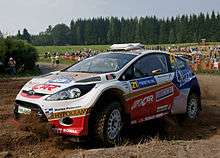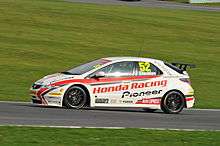Super 2000
| Super 2000 | |
|---|---|
| Motor racing formula | |
| Category | Touring cars Rally cars |
| Country or region | International |
| Championships | Various |
| Inaugural season | 2000 |
| Status | Active |
Super 2000, also known as S2000, is an FIA specification and classification for production based race cars. The specification is split to cover both rally and touring car racing. Super 2000 rally cars are also permitted to compete in Super 2000 World Rally Championship events.[1] The goal of the Super 2000 classification is to allow more manufacturers and privateers to race by reducing the cost of a competitive car. The World Rally Championship currently has five manufacturers fielding teams, while private teams rely on older cars from current manufacturers or from "works" teams that have left the WRC, such as Subaru, Škoda, or Mitsubishi. As of 2015, the World Touring Car Championship, which is open to Super 2000 cars, has four makes of vehicles competing, these being Citroën, Honda, Lada and Chevrolet, with independent teams generally using older cars from previous seasons.
In order to cut costs and shorten development time, the Super 2000 rally cars originally used a common control gearbox and drivetrain made by a French company, Sadev. The FIA has since announced that Xtrac[2] and Ricardo Consulting Engineers will be allowed to also manufacture S2000 gearboxes to FIA specification. This is to further cut costs by introducing competition into gearbox supply.
In effect these new rules allowed Ford to build from scratch their S2000 Fiesta vehicles in Australia, in as little as 14 weeks, starting out with a Super 1600 chassis and rollcage.
Models
Rally cars


 Fiat Grande Punto Abarth S2000, one of the most popular Super 2000 rally cars.
Fiat Grande Punto Abarth S2000, one of the most popular Super 2000 rally cars.

The following WRC-2 (formerly as Super 2000 World Rally Championship) and European Rally Championship (ERC) are the two top rally tournaments that use Super 2000 cars. The Intercontinental Rally Challenge also used the Super 2000 rule in their series' run, before their merger to the ERC.
Super 2000 rally cars are currently in production, or slated for production in the near future:
- Chery A520
- Citroën DS3 RRC[A]
- Fiat Grande Punto Abarth S2000
- Ford Fiesta S2000[3]
- Ford Fiesta RRC[4][A]
- Honda Civic
- MG ZR
- Mini John Cooper Works S2000 1.6T[A]
- Opel Corsa
- Peugeot 207 S2000
- Proton Satria Neo[5]
- Škoda Fabia S2000[6]
- Toyota Auris
- Toyota Corolla / RunX (South African version of Corolla)
- Volkswagen Polo S2000
There was development and testing of a Dacia Logan S2000 car in 2005 but it was not brought into competition.[7]
The new technical regulations for the future FIA World Rally Car were introduced in 2011. S2000 cars would become the new WRC cars, and would be powered by a 1600cc turbo engine instead of the 2000cc used previously. The WRC car would thus be based on the current 2011 model Super 2000 cars, fitted with a supplementary kit, which includes turbo and rear-wing additions.[8] The kit must be able to be fitted or removed within a defined time limit, to be determined.[8][9]
Notes:
| A From 2012 the Regional Rally Car (commonly known as RRC) class was introduced. These cars became fitted with a 1.6 turbocharged engines similar to those used in the WRC cars, and with a smaller restrictor diameter of 30mm instead of 33mm. And with a body kit that also had to comply to the Super 2000 regulations.[4] |
Touring cars
 A Super 2000 BMW 320si competing in the 2009 World Touring Car Championship
A Super 2000 BMW 320si competing in the 2009 World Touring Car Championship A Super 2000 Honda Civic competing in the BTCC
A Super 2000 Honda Civic competing in the BTCC- Fabrizio Giovanardi driving a S2000 Vauxhall Vectra C for the VX Racing team in the British Touring Car Championship.
.jpg) S2000 Chevrolet Cruze's which won the Manufacturers' Championship in the 2010, 2011 and 2012 World Touring Car Championship season.
S2000 Chevrolet Cruze's which won the Manufacturers' Championship in the 2010, 2011 and 2012 World Touring Car Championship season. A S2000 SEAT Leon at the 2009 FIA WTCC Race of Morocco
A S2000 SEAT Leon at the 2009 FIA WTCC Race of Morocco.jpg) A Citroën C-Elysée competing in the 2014 FIA World Touring Car Championship
A Citroën C-Elysée competing in the 2014 FIA World Touring Car Championship
The following cars are going to be built under the TC1 (2014–present) regulations:
The following cars were built under the TC2 Turbo (2011–2013) regulations:
- BMW 320 TC
- Chevrolet Cruze 1.6T
- Ford Focus S2000 TC
- Honda Civic WTCC
- Lada Granta WTCC
- SEAT León WTCC
- Volvo C30 Drive
The following Super 2000 Touring Cars were built to the TC2 (2002–2010) regulations:
- Alfa Romeo 156
- Audi A4
- BMW 120d
- BMW 320i
- BMW 320si
- Chevrolet Cruze
- Chevrolet Lacetti
- Ford Focus ST
- Honda Accord
- Honda Civic
- Honda Civic Type R
- Kia Cee'd
- Lada 110
- Lada Priora
- Lexus IS200
- Mercedes C200
- Opel Astra
- Peugeot 307
- Peugeot 308
- Peugeot 407
- SEAT León TFSI
- SEAT León TDI
- SEAT Toledo
- Toyota Auris
- Toyota Avensis
- Toyota Corolla
- Vauxhall Vectra
- Volkswagen Scirocco
- Volkswagen Golf
- Volvo C30
- Volvo S60
Specifications
FIA specifications include the following:[10][11]
- Derived from production model, of which at least 2500 have been produced in the past year
- Maximum of 2 liter (2000 cc) displacement
- Normal Aspiration, Rally: 8500 rpm maximum, Circuit: 8500 rpm maximum for 4 cylinders, 8750 rpm maximum for 5 cylinders, 9000 rpm maximum for 6 cylinders.
- All wheel drive is permitted in rally cars, but not in touring cars.
- 6-speed sequential gearbox (Control specification), or 5-speed MT gearbox retaining original gear ratios.
- Front and rear MacPherson suspension
- No electronic driver aids
- Must be for sale at a maximum price of €168,000.[12]
Series
Super 2000 spec cars are currently run in:
Rally Competitions:
- World Rally Championship (as specification of World Rally Car)
- World Rally Championship-2 (formerly Super 2000 World Rally Championship or S-WRC)
- European Rally Championship (including the former Intercontinental Rally Challenge)
- Asia-Pacific Rally Championship
- Australian Rally Championship
- Italian Rally Championship
- Codasur South American Rally Championship
- South African Rally Championship
Touring Car competitions:
- World Touring Car Championship
- European Touring Car Cup
- ADAC Procar Series
- Dominican Touring Series
- Russian Touring Car Championship
- Asian Touring Car Series
South Africa was the first country in the world to run Super 2000 cars in rallying. Toyota South Africa and Volkswagen South Africa each built 2 cars to compete in the South African Rally Championship in 2005.
See also
- Diesel 2000, the related category for diesel powered touring cars
- Super 1600, a rally car formula that is primarily used in the Junior World Rally Championship
- Super 2000 World Rally Championship, a companion rally series to the World Rally Championship
References
- ↑ "207 RCup". Peugeot.com. Retrieved 2010-12-12.
- ↑ "Xtrac 532 S2000 gearbox press release" (PDF). Retrieved 2010-12-12.
- ↑ "RallySport Magazine - S2000 Fiestas nearly ready to roll". Rallysportmag.com.au. 2007-03-15. Retrieved 2010-12-12.
- 1 2 http://www.m-sport.co.uk/index.php/motorsport/the-rally-cars/ford-fiesta-rrc
- ↑ "Rally : A new Proton Super 2000? - PROTON WRC". Rally-Live.com. Retrieved 2010-12-12.
- ↑ "Skoda starts S2000 testing. | WRC News". Crash.Net. 2008-02-14. Retrieved 2010-12-12.
- ↑ rally | Shock: Ecco i primi scatti della Dacia Logan S2000!
- 1 2 http://www.crash.net/motorsport/wrc/news/161223-0/stay_of_execution_for_wrc_cars.html
- ↑ "maps out the future of the WRC". Wrc.com. Retrieved 2010-12-12.
- ↑ "Microsoft Word - 263 _07-08_.doc" (PDF). Retrieved 2010-12-12.
- ↑ "FIA Super 2000 Rally regulations" (PDF). Retrieved 2010-12-12.
- ↑ "RallySport Magazine - Super 2000 is affordable - RED". Rallysportmag.com.au. 2007-02-05. Retrieved 2010-12-12.
External links
| Wikimedia Commons has media related to Super 2000. |
![]() Rallying – Wikipedia book
Rallying – Wikipedia book
![]() Touring car racing – Wikipedia book
Touring car racing – Wikipedia book